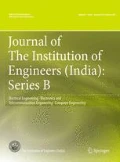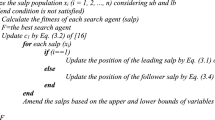Abstract
This paper deals with the coordination of economic load dispatch and load frequency control concepts of the interconnected power system. The total change in the particular control area is shared by each unit according to their participation factor obtained from the calculation of the economic load dispatch. In this work, two control areas are considered, the first control area contains the combination of hydro, thermal and gas generating unit and in the second control area, it contains the combination of the thermal and hydro generating units. Integral controller is used for secondary controller for load frequency control mechanism. A digital simulation is used in conjunction with the genetic algorithm (GA) technique to determine the optimum parameters of the individual gain of integral controller. Three different types of performance indices are considered to measure the appropriateness of the proposed controller. The optimum values of the gains improve the dynamic performance of the controller and reduce the overshoot and maximum frequency deviation and net tie-line power flow deviation error for a particular load change. To show the effectiveness of the proposed controller, simulation result is shown in result and discussion section.








Similar content being viewed by others

References
Y.L.A. Magid, M.M. Dawoud, Tunning of AGC of interconnected reheat thermal systems with genetic algorithms. IEEE (1995)
L. Pingkang, X. Du, Multi-area AGC system performance improvement using GA based fuzzy logic control. The International Conference on Electric Engineering (2009)
T. Sasaki, K. Enomoto, Dynamic analysis of generation control performance standards. IEEE Trans. Power Syst. 17, 806–811 (2002)
L. Dong, Y. Zhang, Z. Gao, A robust decentralized load frequency controller for interconnected power systems. ISA Trans. 51, 410–419 (2012)
A. Konark et al., Multi-objective optimization using genetic algorithm, a tutorial. Realiz. Eng. Syst. Saf. 91, 992–1007 (2006)
I. Ibraham, O. Singh, N. Hassan, Genetic algorithms based scheme for optimization of AGC gains of interconnected power system. J. Theor. Appl. Inf. Technol. 2005–2009, 33–39 (2009)
I. Ibraheem, P. Kumar, D.P. Kothari, Recent philosophies of automatic generation control strategies in power systems. IEEE Trans. Power 20, 346–357 (2005)
S. Ohba, H. Ohnishi, S. Iwamoto, An advanced LFC design considering parameter uncertainities in power systems. IEEE Trans. Power Syst. 22, 630–635 (2007)
M. Aldeen, R. Sharma, Robust detection of faults in frequency control loops. IEEE Trans. Power Syst. 22, 413–422 (2007)
W. Tan, H. Zhou, Robust analysis of decentralized load frequency control for multi-area power system. Electr. Power Energy Syst. 43, 996–1005 (2009)
I.A. Chidambaram, B. Paramasivam, Design of decentralized biased controller for load frequency controller for interconnected power systems. Electr. Power Compon. Syst. 33, 1313–1331 (2005)
K.P. Singh Parmar, S. Majhi, D.P. Kothari, Load frequency control of a realistic power system with multi-source interconnected power system. Electr. Power Energy Syst. 42, 426–433 (2012)
IEEE Committee Report, Dynamic model for steam and hydro turbines in power system studies. Trans. Power Appar. Syst. 92(6), 1904–1915 (1973)
IEEE Working Group Report, Dynamic models for fossil fuelled steam units in power system studies. IEEE Trans. Power Syst. 6(2), 753–761 (1991)
W.I. Rowen, Simplified mathematical representation of heavy duty gas turbine. Trans. ASME J. Eng. Power 105, 865–870 (1983)
K.P. Singh, S. Majhi, D.P. Kothari, LFC of an interconnected power system with multi-source power generation in deregulated power environment. Electr. Power Energy Syst. 57, 277–286 (2014)
I.A. Chidambaram, S. Velusami, Design of decentralized biased controllers for load frequency control of interconnected power systems. Int. J. Electr. Power Compon. Syst. 33, 1313–1331 (2005)
S. Velusami, I.A. Chidambaram, Decentralized biased dual mode controller for LFC of interconnected power systems considering GDB and GRC nonlinearities. Energy Convers. Manag. 48, 1691–1702 (2007)
Y.L. Abdel-Magid, M.M. Dawoud, Optimal AGC tuning with genetic algorithms. Electr. Power Syst. Res. 33, 231–238 (1996)
K. Chatterjee, PI controller for automatic generation control based on performance indices. Int. J. World Sci. Eng. Technol. 75, 321–328 (2011)
Acknowledgments
The authors sincerely acknowledge the financial support provided by the Indian School of Mines (ISM) Dhanbad, India for carrying out the present work.
Author information
Authors and Affiliations
Corresponding author
Appendix
Appendix
Steam Power System
K r (coefficient of re-heat steam turbine) = 0.3,
T r (re-heat time constant) = 10 s
T t (turbine time constant) = 0.3 s,
R thi (speed governor regulation) = 2.4 Hz/pu MW
T g (speed governor time constant) = 0.08 s,
T W (water time constant) = 1.0 s
R hyi (speed governor regulation) = 2.4 Hz/pu MW
Gas Power System
X (speed governor lead time constant) = 0.6 s,
Y(speed governor lag time constant) = 1.0 s,
Valve positional constant a = 1, b = 0.05 and c = 1,
T F (full time constant) = 0.23 s
T CR (combustion reaction time delay) = 0.01 s,
T CD (compressor discharge volume time constant) = 0.2 s,
R g (speed governor regulation) = 2.4 Hz/pu MW
Hydro Power System
T R (speed governor rest time) = 5.0 s,
T RH (transient droop time constant) = 28.75
T GH (main servo time constant) = 0.2 s
Rights and permissions
About this article
Cite this article
Shankar, R., Chatterjee, K. & Chatterjee, T.K. Coordination of Economic Load Dispatch and Load Frequency Control for Interconnected Power System. J. Inst. Eng. India Ser. B 96, 47–54 (2015). https://doi.org/10.1007/s40031-014-0113-0
Received:
Accepted:
Published:
Issue Date:
DOI: https://doi.org/10.1007/s40031-014-0113-0



